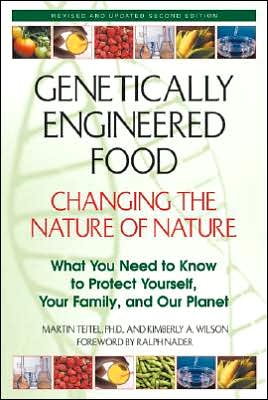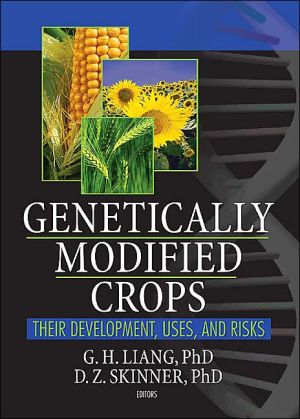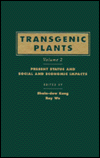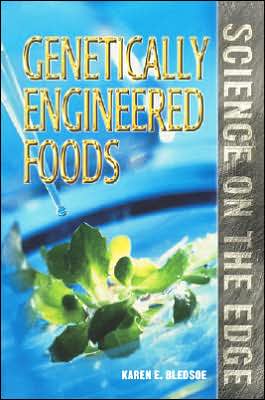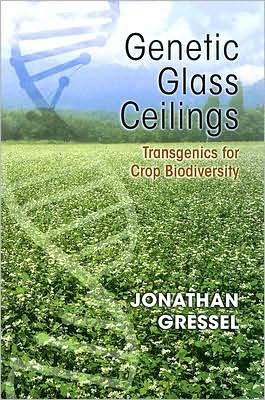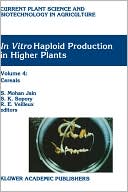Genetically Engineered Foods: Changing the Nature of Nature: What You Need to Know to Protect Yourself, Your Family, and Your Planet
• The book that takes a comprehensive look at the threat to our food supply from genetic engineering. • 15,000 copies sold in the first six months. • Includes new studies about the dangers of genetically engineered food. • Refutes the "feed the poor" propaganda spread by agribusinesses. • Is both an expose and educational primer on this controversial technology that is already a part of every American's diet. • Explains the dangers of these foods...
Search in google:
• The book that takes a comprehensive look at the threat to our food supply from genetic engineering. • 15,000 copies sold in the first six months. • Includes new studies about the dangers of genetically engineered food. • Refutes the "feed the poor" propaganda spread by agribusinesses. • Is both an expose and educational primer on this controversial technology that is already a part of every American's diet. • Explains the dangers of these foods to ourselves and our environment in easily understood terms. Picture a world?• Where the french fries you eat are registered as a pesticide, not a food. • Where vegetarians unwittingly consume fish genes in their tomatoes. • Where corn plants kill monarch butterflies. • Where soy plants thrive on doses of herbicide that kill every other plant in sight. • Where multinational corporations own the life forms that farmers grow and legally control the farmers' actions. That world existsThese things are all happening, and they are happening to you. Genetically engineered foods--plants whose genetic structures are altered by scientists in ways that could never occur in nature--are already present in many of the products you buy in supermarkets, unlabeled, unwanted, and largely untested. The threat of these organisms to human and environmental health has caused them to be virtually banned in Europe, yet the U.S. government, working hand-in-hand with a few biotech corporations, has actively encouraged their use while discouraging labeling that might alert consumers to what they are eating. The authors show what the future holds and give you the information you need to preserve the independence and integrity of our food supply. What can you do? First, inform yourself. Genetically Engineered Food: Changing the Nature of Nature is the first book to take a comprehensive look at the many ramifications of this disturbing trend. Authors Martin Teitel and Kimberly Wilson explain what genetic engineering is and how it works, then explore the health risks involved with eating organisms never before seen in nature. They address the ecological catastrophe that could result from these modified plants crossing with wild species and escaping human control altogether, as well as the economic devastation that may befall small farmers who find themselves at the mercy of mega-corporations for their livelihood. Taking the discussion a step further, they consider the ethical and spiritual implications of this radical change in our relationship to the natural world, showing what the future holds and giving you the information you need to act on your own or to join others in preserving the independence and integrity of our food supply. Martin Teitel, Ph.D., the author of Rain Forest in Your Kitchen, is Executive Director of the Council for Responsible Genetics. He lives in Boston. Kimberly A. Wilson, former director of the council's program on Commercial Biotechnology and the Environment, works with the Greenpeace biotechnology campaign and lives in San Francisco. Orion Afield . . . a comprehensive and persuasive primer that is guaranteed to make readers take this new and daunting aspect of food production seriously.
Introduction\ Hijacked Dinner\ Imagine yourself one morning on a modern jetliner, settling into your seat as the plane taxis toward the active runway. To pass the time you unfold your morning newspaper, and just as the plane's rapidly building acceleration begins to lift the wheels from the ground, your eye catches a front page article mentioning that engineers are beginning a series of tests to determine whether or not the new- model airplane that you are in is safe. That situation would never happen, you say to yourself. People have more foresight than that. Yet something we entrust our lives to far more often than airplanes-our food supply-is being redesigned faster than any of us realize, and scientists have hardly begun to test the long-term safety of these new foods.\ The genetic engineering of our food is the most radical transformation in our diet since the invention of agriculture 10,000 years ago. During these thousands of years, people have used the naturally occurring processes of genetics to gradually shape wild plants into tastier, more nutritious, and more attractive food for all of humanity. Until very recently, these evolved food plants were part of the common heritage of humankind. Food plants have been available to all in conveniently small and storable packets-seeds-for distribution, trade, and warehousing. In fact, selective plant breeding has brought food security, greater nutrition, and increased biodiversity, while at the same time protecting food systems against hard times, like natural or economic disasters.\ In the new kind of agriculture, a handful of giant corporations have placed patents on food plants, giving them exclusive control over that food. These transnational corporations have altered the minute life-processes of food plants by removing or adding genetic material in ways quite impossible in nature. And like our nightmare vision of the untested airplane, genetically altered food is being quietly slipped into our markets and supermarkets without proper labels, and without having passed adequate safety tests. Furthermore, genetically engineered food confers no advantage to consumers: it doesn't look better, taste better, cost less, or provide better nutrition. To distinguish this different sort of food from the natural food we have eaten all our lives, people give it different names. In Europe they call it "GMO food." Here, we use a new term: "genfood."\ While we eat this new kind of food and feed it to our children on a daily basis, independent scientists are just beginning to conduct tests to learn about the food's safety. In fact, a person in the United States shopping in a modern supermarket would find out that most food products contain genetically modified ingredients-but the lack of useful labeling of genetically engineered food keeps this information hidden. Meanwhile, economists are determining if our local and national farming will be hurt by this dramatic change in agriculture, and environmentalists are considering the ecological damage that genetically modified plants may cause. Unfortunately these food crops are already growing on millions of acres all around our world: at the end of the twentieth century enough genetically engineered crops are being grown to cover all of Great Britain plus all of Taiwan, with enough left over to carpet Central Park in New York. With this abrupt agricultural transformation, humanity's food supply is being placed in the hands of a few corporations who practice an unpredictable and dangerous science.\ As we eat genetically altered food and read about new safety tests, we may start to realize that we are the unwitting and unwilling guinea pigs in the largest experiment in human history, involving our entire planet's ecosystem, food supply, and the health and very genetic makeup of its inhabitants. Worse yet, results coming in from the first objective tests are not encouraging. Scientists issue cautionary statements almost weekly, ranging from problems with monarch butterflies dying from genetically modified corn pollen to the danger of violent allergic reactions to genes introduced into soy products, as well as experiments showing a variety of actual and suspected health problems for cows fed genetically engineered hormones and the humans who drink their milk. And this doesn't even consider slow-acting problems that might not show up for years or decades. Who decided this was an acceptable risk?\ On the economic front, trade wars are starting to break out around the world as the countries that produce genetically modified food seek to force other nations to accept it, even when such modified food provides no benefit to recipient nations and raises all the risks mentioned above. Meanwhile, environmental activists warn of "superweeds" and "superbugs" being created by genes that escape from genetically engineered plants. And the file of court cases grows as people questioning this new technology are sued into silence and as activists around the world demonstrate to express their concerns.\ Three features distinguish this new kind of food. First and most important, the food is altered at the genetic level in ways that could never occur naturally. As genes from plants, animals, viruses, and bacteria are merged in novel ways, the normal checks and balances that nature provides to keep biology from running amok are nullified. Exactly how genes work is a topic of enormous complexity and some controversy, so it is difficult if not impossible to predict what will happen when individual combinations of genes are created in ways that have never been seen before-and then released into the environment.\ The second novel feature of the revolution in our food is that the food is owned. Not individual sacks of wheat or bushels of potatoes, but entire varieties of plants are now corporate products. In some cases, entire species are owned. The term "monopoly" takes on new power when one imagines a company owning major portions of our food supply-the one thing that every single person now and into the future will always need to buy.
AcknowledgmentsviiForewordixIntroduction: Hijacked Dinner11.How Genetic Engineering Works62.What's in Your Grocery Cart?203.You Are What You Eat464.Your Right to Know625.Food Fights796.Fields of Green: Farming and Biotech897.Crossing Swords with an Angel1078."We Will Feed the World"1149.What the Future Holds12910.The Light at the End of the Tunnel: What You Can Do142Appendix AOrganic Seed Saving163Appendix BRelated Web Sites167Appendix COrganizations172Notes177Suggested Reading189Index197
\ Vermont Times" . . . thorough and alarming. People who are concerned about their health and the health of the planet should read this book." \ \ \ \ \ \ Orion Afield. . . a comprehensive and persuasive primer that is guaranteed to make readers take this new and daunting aspect of food production seriously.\ \
